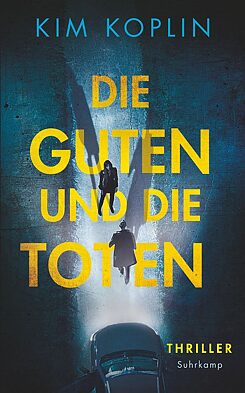Drugs, guns, murders in a multistorey car park: there’s plenty going on in Kim Koplin’s debut crime novel. We are taken on a hectic trip through Berlin, where somebody is always on the run. And in amongst it all we have a detective with problems at home and a night watchman with a daughter and a past.
As the title Die Guten und die Toten (i.e. The Good and the Dead) already suggests, more than one dead body turns up in Kim Koplin’s debut thriller. And then there are the good guys who are not dead. Judging by the character of Koplin’s protagonists, we need not fear for the lives of the father, the daughter or the friend, as they are definitely the good guys. They also include Nihal Khigarian, a young detective superintendent with Azerbaijani roots. She sometimes loses her cool and has to work on her “emotional control”. Her dream being to compete in the Olympic Games as a boxer, she is more likely to resolve conflicts with her fists than with words. Everything about this fast-paced Berlin thriller, from the language used to the attitude of the characters towards laws, drugs and guns, is equally unorthodox. And this despite the novel being set for the most part in the staid middle-class district of Charlottenburg, albeit in the “city’s crappiest multistorey car park” with the worst Google rating ever. The hipper districts do not feature at all.Dirty politics
A state secretary from the economics ministry is one particularly nasty piece of work in this thriller – which definitely adds to the tension. Though the plot line featuring the politician trots out every possible cliche, this does nothing to detract from the story: his high-end call girl is studying Chinese and drugs are being gobbled up like Smarties, the whole lot being funded by the state secretary’s involvement in dodgy arms deals with Saudi Arabia. In a sub-plot we have an up-and-coming young journalist who is busy investigating this illegal arms trade.Saad and Nihal – how it all began
The detective superintendent has a good-for-nothing brother who she is allowing to stay temporarily in her far too small and poorly soundproofed flat. By way of “thanks”, he brings one “party bitch” after another back home with him, spends the entire time smoking dope and drives his sister crazy with his infinite lack of consideration and – worst of all – petty criminal activities. After fleeing from her own flat early one morning, Nihal comes across carpark night watchman Saad and his four-year-old daughter at the S-Bahn station, where they are being hassled by a couple of right-wing extremists.What Nihal doesn’t realize is that Saad escaped the clutches of the drug mafia in Marseille and could easily defend himself against his attackers, as violence is no problem for him. However, he is doing his best to keep under the radar so as to do nothing to jeopardize his residence status as an alleged refugee from Syria. Instead, Nihal comes to the help of father and daughter, paving the way for their three-way relationship to take its course.
Their paths cross again when murders are committed in Saad’s multistorey car park and corpses need to be got rid of. But that’s all the spoilers for now.
Big city life, warts and all
Kim Koplin’s thriller is definitely to be recommended: it is the perfect entertaining read for anyone who doesn’t mind the brash urban slang spoken by young city dwellers, who enjoys tension, fast-paced action plus off-beat and rather unpolished characters, and who appreciate the clarity of short and pithy sentences. It’s lots of fun to join Kim Koplin on a rollercoaster tour of settings such as Savignyplatz, Schwarzes Café and the trendy restaurant “Borchardt”, a meeting place for journalists, politicians and celebrities alike, and not to be bored for an instant.Incidentally, Kim Koplin is a pseudonym for an author who lives in Berlin, France and Italy and has already written a number of successful books – these are the scant details provided by the publisher Suhrkamp that only serve to make one even more curious.
Kim Koplin: Die Guten und die Toten. Thriller
Berlin: Suhrkamp, 2023.254 p.
ISBN: 978-3-518-47312-2
You can find this title in our eLibrary Onleihe.
October 2023


